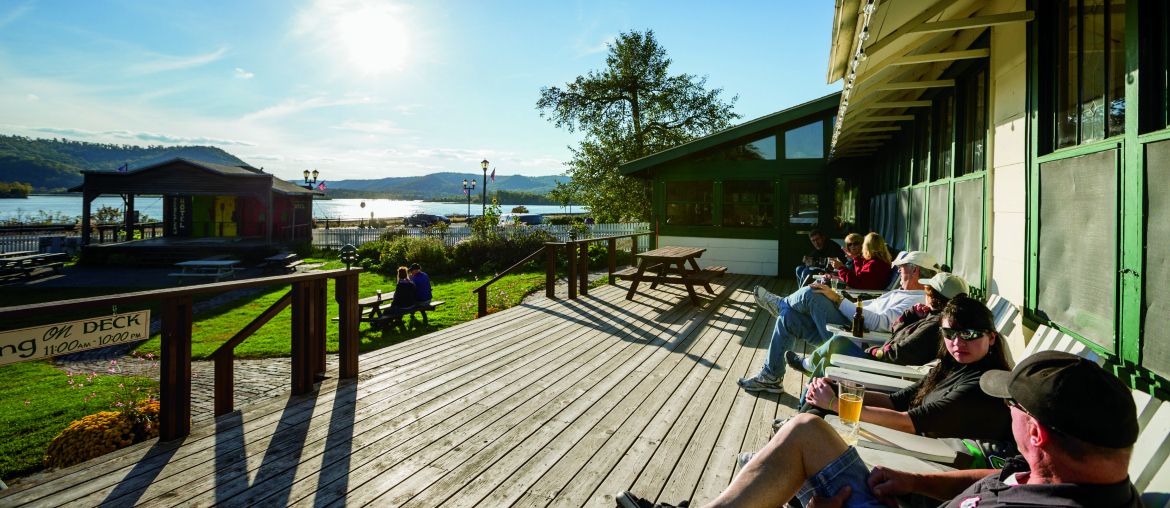Viewed from Buena Vista Park, high on a bluff overlooking the Mississippi River, the river town of Alma has the picturesque quality of a child’s toy set. Tiny houses and storefronts ordered along Main Street, toy trains clacking along tracks on a narrow strip between river and town, and miniature barges making their way toward Lock and Dam No. 4. The only thing that doesn’t look miniature is the Mighty Mississippi.
The Mississippi River — “Great River” to native Ojibwa — is the fourth longest river in the world. It flows through or borders 10 states and drains all or parts of 31 states and two Canadian provinces before emptying into the gulf of Mexico. It is the inspiration for much poetry, prose and song, including “Old Man River.”
Native Americans lived along the Mississippi for centuries — hunter- gatherers, herders and the agrarian mound builders. Though much evidence of Native American life on the river has been obliterated, a few mounds remain at Perrot State Park, where the remnants of native American activity date back at least 4,000 years. Several museums along the route have artifacts and tell some of the Native American story.
In the 1500s, Europeans arrived as explorers, fur traders and immigrants who settled communities of Swiss, German, French, Italian and Swedish heritage. In the 19th century, the Mississippi and its tributaries helped spur westward expansion. During both peacetime and wartime, the river served as a vital transportation and communications route. Capture of the river by union forces was a turning point in the Civil War, because the Confederacy relied on it as a trade route.
The Great River Road was established in 1938 by FDR to pay tribute to the scenic, cultural and historic appeal of the Mississippi and its environs. In 2000, a four-state segment of the great river road (including Wisconsin’s Highway 35) was designated a national scenic byway, placing it in the company of such iconic byways as Historic Route 66, the Blue Ridge Parkway and the Santa Fe trail. It’s been voted “prettiest drive,” more than once, most recently by the Huffington Post.
“While the modern river has been transformed by humans, the most visible being a system of locks and dams, its geologic history is still evident,” says UW-LaCrosse geomorphologist Colin Belby. The real story of the Mississippi River landscape, he says, began with shallow tropical oceans that spread over the area some 550-450 million years ago. Sediment that was deposited in these seas and exposed as the seas gradually disappeared forms the bedrock of today’s landscape. Fast forward to just a few million years ago. During the past 2.5 million years, glaciers repeatedly advanced across much of Wisconsin and Minnesota, abrading the land in some areas and depositing thick layers of sediment in others. Glacial action buffed the high points and filled in the low points, forming the subtle undulating topography of Northwest Wisconsin.
During the most recent glacial advance, the ice reached its most southerly extent in Wisconsin about 18,000 years ago. From then until 10,000 years ago when the glaciers completed their retreat, glacial meltwater formed rivers and streams, which occasionally got dammed up by ice and debris. Every time one of those natural dams broke loose, a massive outpouring of water caused more erosion in some places and deposition in others, shaping the path of the Mississippi as we know it today.
The Wisconsin Great River Road runs along Highway 35, beginning at Prescott in the north and passing through 33 towns, 50 parks, beaches, recreational areas and water access sites as it wends 250 miles south to its southern gateway town of Kieler.
The route’s 33 river towns are the heartbeat of Wisconsin’s Great River Road. This is where you’ll find the festivals, markets, museums and historic markers that give the route much of its character and romance.
Prescott, the route’s northern gateway has a Welcome and Heritage Center housed in a circa 1885 bank building. Two rivers join at Prescott, the clear waters of the St. Croix churning into the muddy Mississippi. Just down the road, Diamond Bluff is named for distinctive dolomite bluffs that rise above town and serve as a landmark for river traffic. A memorial plaque at sea Wing Park tells of the tragic sinking of the Sea Wing, a pleasure barge that capsized during a summer storm in 1890, killing 98 of its more than 200 passengers.
The historic town of Bay City lies at the top of lake Pepin, the first of four towns on this shallow lake. Lake Pepin is formed by a natural dam that occurs where the Chippewa river flows into the Mississippi river floodplain. “The Chippewa river carries a large sandy sediment load, forming a delta where it joins the Mississippi,” says Paul Reyerson, another UW-LaCrosse geomorphologist. “That causes the Mississippi to back up, essentially damming the river and creating lake Pepin.” This popular recreational lake is the naturally widest point on the Mississippi river, with a surface area of 40 square miles.
Stockholm, also on the shores of Lake Pepin, was settled in the mid-19th century and in recent decades has become an artist’s enclave. for over 40 years, the juried Stockholm Art Fair has been held the third Saturday in July. This year, more than 100 artists will showcase their creations.
Next stop is Pepin, birthplace of one of America’s best-loved storytellers — Laura Ingalls Wilder. The Little House Wayside, seven miles north of town, has a replica of the log cabin that was the “Little House in the Big Woods,” the first of Ingalls Wilder’s “Big House” books. In town, Pepin Village Park has a Laura Ingalls Wilder memorial, the Pepin Depot Museum and Pepin Historical Museum.
As we pass Nelson, where the Chippewa River flows into the Mississippi, the topography is older than the glaciated landscape to the north. This part of Wisconsin, known as the Driftless Area, was never covered by glaciers, resulting in bluffs that are craggier and more pronounced. Over several million years, rivers throughout the Driftless Area of southwest Wisconsin carved the landscape, forming the spectacular coulees and bluffs we see today.
Picturesque Alma is just two streets wide, much of it terraced between bluff and river, with 10 stair-stepped streets running perpendicular to the river. Farther downstream, in Fountain City, you can glimpse a bit of modern geology: a 55-ton boulder crashed into a small house, coming to rest in a bedroom; for a modest donation, you can see it for yourself. You can also visit Seven Hawks Vineyard, one of six Wisconsin wineries on the three-state Great River Road Wine Trail.
At Trempealeau, you can hike Perrot State Park and see the few remaining burial mounds, have lunch at the historic Trempealeau Hotel and watch river traffic make its way through lock and dam no. 6. At Holmen, explore the 4,000-acre Van loon Wildlife Area. From foot trails or from rustic road 64 (7 bridges road), you can see historic MacGilvray bridges, seven steel arch truss bridges built in the late 19th/early 20th centuries. The 7 Bridges Road is just one of 24 designated Rustic Roads within an easy drive of the Great River Road.
The La Crosse Riverside Museum and Great River Road Interpretive Center are worth a visit, along with the Mississippi River Archaeology Center at UW-La Crosse. Here you can even get out on the river for a cruise, aboard the La Crosse Queen.
At Genoa, take a tour at the Genoa National Fish Hatchery and visit a thousand-gallon aquarium of Mississippi River fish species. At Lynxville, the spring and fall migration brings tens of thousands of canvasback ducks to the pool above lock and dam no. 9. As much as 75 percent of the canvasback population in the U.S. gathers at this pool.
Wisconsin history is much in evidence at Villa Louis at Prairie du Chien, Wisconsin’s second oldest community. Nelson Dewey State Park commemorates Wisconsin’s first governor, who lived at nearby Stonefield. both Villa Louis and Stonefield are Wisconsin Historical Society museum sites. And nearby Cassville once competed to become capital of the Wisconsin Territory.
Wyalusing State Park overlooks the confluence of the Mississippi and Wisconsin rivers, with miles of hiking trails and many scenic views. Just south, Potosi has the longest main street in the world, and is home to the historic Potosi brewery, complete with beer garden, national brewery Museum and the great river road Interpretive Center.
The Dickeyville Grotto is an impressive exhibit of outdoor art, created by a parish priest and his congregation between 1925 and 1930. The collection of shrines and monuments were turned into mosaics, creating an eye-catching display in spiritual and patriotic themes.
Wisconsin’s Great River Road is a satisfying blend of history, quirky attractions and countless recreational opportunities from biking and hiking to canoeing and birding. Along the way, the people of Wisconsin welcome visitors to their towns with classic Midwest hospitality.
This article originally appeared in the 2015 spring/summer issue of Experience Wisconsin magazine. The contents of this article were checked for accuracy when it was published; however, it’s possible some of the information has changed. We recommend you call first if you have specific questions for the destinations, attractions or restaurants mentioned in this article.
No portion of this article or magazine may be reproduced without prior written permission by the publisher.






1 Comment
Pingback: Your Great River Road Five-Day Itinerary | Experience Wisconsin